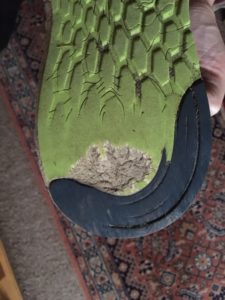Electronics:
- 1-2 Powerbanks, charged (depends on duration of the run and dropback strategy)
- GPS watch (do not forget to upload the track and make sure that you were successful)
- GPS watch cable
- GPS handheld with charged batteries (upload the track)
- 1-2 sets of additional batterie sets for GPS handheld (charged)
- Headlamp with charged batteries
- 1-2 sets of additional batterie sets for headlamp (charged)
- Smartphone
- Smartphone cable
- Smartphone earphones
- GPS tracker (if you have one)
- Signal light (to be attached to your clothings/backpack for road safety and to annoy following runners; sometimes mandatory in races)
Backpack Brainstorming:
If you happen to have several ones – be sure that you know what they are capable of and decide according to your upcoming run. Do you need to be fast? Do you have a lot of dropbacks so that you can refill every other day? Do you need to carry everything all the time? Really? The normal tendency is to overpack – be aware of that and consider to reduce stuff. Make sure that you are aware of the weather conditions during your run as good as possible. Heat and sweat, rain, cold – all that may have an influence on your backpack choice. Be aware where your backpack will destroy your body if you do mistakes while packing and running – do not do these mistakes.
Shoes & Feet:
Well, this is a delicate and personal thing. You may want to:
- tape your feet to slow-down the blister formation (I use Kinesiotape) or treat your feet with your strategy to keep them as long as possible as intact as possible
- be ready to renew that tape/retreat your feet on CPs (if any)
- if you want to re-tape you need a towel to dry and clean your feet, a needle or scissor (to burst blisters) and fresh socks in your dropback or backpack
- if you have the time at CPs and your feet are in miserable conditions a break of 30-60 min may help to completely dry your feet (a fan helps to speed-up this process)
- know the pros and cons of your socks and shoes and the parts of your feet they will destroy
- consider to wear water-proof socks (be aware that they will not be proof forever)
- consider to wear thin, comfortable socks under your water-proof socks
- consider to remove the insole of your shoes when wearing thick water-proof socks (the thick socks cover-up for the missing insole and the gained space is a relieve for your swelling feet
- changing shoes (if possible) may be an option to think about – be aware that your feet will swell and hurt so you may want to change into wider and comfortable shoes
- be aware that you will be on one point of your long run no longer able to change our shoes
- Read for more details about feet especially in wet conditions this!
Clothing:
Check the weather forecast and dress accordingly – only use stuff you know and you trained in and feel comfortable in. Here are a couple of helpful things to consider:
- Buffs, hats, gloves and arm warmers are really nice tools to keep your temperature feelings ideal and are easy to remove/put on while running
- Protect your head from direct sunlight
- Wear sunglasses if you can run with them – this seems unnecessary but to keep stress from your eyes helps you to stay relaxed
- Wear underwear and socks you know and which are suitable for what your are doing to prevent chafing as good as possible
- Plan carefully what you need in your backpack/dropbacks to change clothing
- Always carry at least a light wind/waterproof jacket with you
- Keep in mind that you tend to feel colder and start shivering the longer the race lasts
- Check mandatory equipment when racing
Safety & Hygiene
- Vaseline/Nok cream/others – to prevent chafing wherever you want to prevent it
- First-aid kit (fully equipped)
- Do not forget your meds if you need some regularly
- Bring safety blankets/sleeping backs (handy if you for whatever reason need to sleep or dye)
- Check mandatory equipment when racing
Food & Drinks
That is up to you. Whatever helps you to stay up and running. Apart from that:
- make sure that your water management is fine-tuned – check for places where you can get water during your run and mark them on your GPS
- Salt pills next to water are important and may help to keep you ok (esp. in warm conditions)
- I tend to use caffein pills when the seriously tired moments start
- Coke (just kidding)
Others:
- Poles (in some races you need to carry them all the time, in some races it is allowed to pick them up at later CP)
- some packs handkerchiefs
- ID, creditcard/bank card, 100 € cash
- (Car)keys
- FFP2/medical mask
- Coins for vending machines
- fatty lipstick (especially in cold conditions) to pretend your lips from cracking
- if go into the void – take a water filter with you
- pack your car with whatever you need after finishing your run
More helpful packing list considerations can be found here
To be completed.




